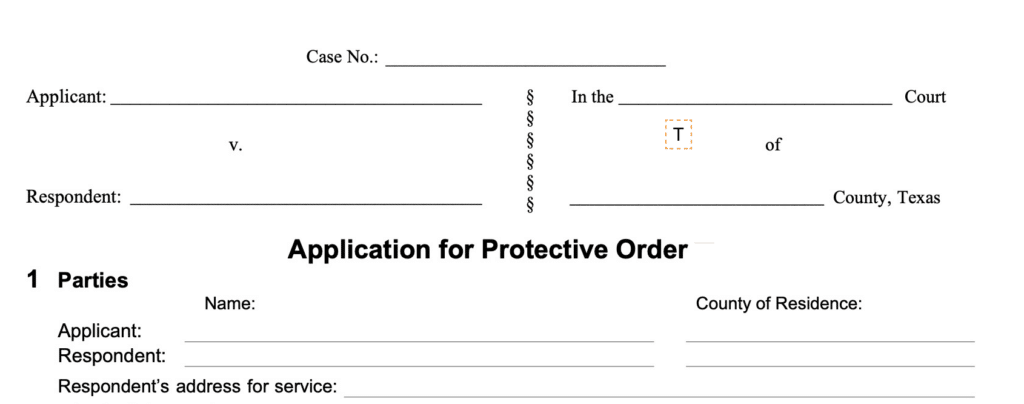- Protective orders are typically issued in cases involving family violence
- If you reconcile after a protective order is issued, both parties must petition the court to have the order rescinded or amended
- A protective order is not the same as a restraining order
Family violence is one of the most common charges we see, and in recent years, Texas courts have issued approximately 30,000 to 40,000 protective orders per year.
A protective order is issued by a court to protect someone from harassment, abuse, stalking, or threats by another person. They are typically issued in family violence cases, but they can also be issued in other situations where your safety is at risk.
But what does it restrict? Read on to learn why protective orders are issued and what happens if you violate one.
What we’ll cover here
- Why are Protective Orders Issued?
- Three Types of Protective Orders
- How to Get a Protective Order
- Requirements for a Protective Order
- How long does a PO last?
- What Happens If I Violate a Protective Order?
- Protective Order vs. Restraining Order: What’s the Difference?
- How Long Can I Go to Jail if I Violate a Protective Order?
Why are Protective Orders Issued?
There are different types of protective orders (with different restrictions) based on the allegations against you. Most protective orders are issued in cases involving:
- Domestic abuse
- Dating violence
- Sexual assault
- Stalking
- Human trafficking
The main purpose of a protective order is to prevent further harm to the person who is seeking protection (aka the petitioner). It establishes guidelines for the defendant’s actions.
For example, it could be considered a violation if:
- You threaten, harass or hurt your spouse, partner, or your children (even through another person)
- You go to places where the protective order has explicitly prevented you from going – this includes your home, workplace, and any schools
- You carry guns
- You track or monitor your family, your property, or another household member, either with a tracking device or physically following someone
The judge can also:
- Evict offenders from their home
- Order child support payments
- Order medical support payments
- Set child visitation conditions
- Require participation in anger management classes
- Order drug testing
- Require participation in substance abuse treatment programs
- Require your cell phone to be transferred to a separate account from the rest of your family
We have seen cases where the sole homeowner is evicted from their own home and ends up sleeping in their car after a partner who is not listed on the property deed is granted sole access. If this happens to you, contact us immediately.
Three Types of Protective Orders
There are three types of protective orders in Texas. How long an order will remain in effect will depend on which type is issued.
| Type of order | Timeframe | When they’re issued |
| Temporary ex parte | Valid for 20 days | A judge must determine there is a risk of family violence to the petitioner or a family member. The alleged abuser does not need to be present at the hearing |
| Emergency protective order | 31 to 91 days | These are mandatory if an offense involves serious bodily injury or showing or using a deadly weapon during the alleged offense |
| Permanent protective order | Two years | These can’t be issued ex parte, so the defendant must be present during the hearing |
How to Get a Protective Order
Civil courts issue temporary ex parte and and permanent orders, which are obtained by filing an application with the court clerk, while criminal courts issue emergency orders. A judge will typically issue an emergency order if the case against you involves serious harm or the incident involved a deadly weapon.
Any of the following can petition for a protective order in civil court:
- Victims of family violence
- Victims of dating violence
- Victims of sex assault, stalking, or human trafficking
- Adult members of households where the above incidents occurred
- Adults seeking protection for a child
- A prosecutor or law enforcement officer
- Some government agencies, including the Texas Department of Family and Protective Services (DFPS)

Requirements for a Protective Order
To obtain a protective order in Texas, a petitioner must meet specific requirements, which are outlined in the Texas Family Code. The primary requirement is that there must be a qualifying relationship between the petitioner and the defendant.
There also needs to be evidence that a crime was committed. For example:
- If a petitioner is alleging family violence, they must show that violence has occurred
- If the petitioner’s allegations involve stalking, sexual assault, or human trafficking, there must be evidence that an offense was committed
How long does a PO last?
Permanent family violence protective orders typically last two years, but they can be for longer durations, including for life. Protective orders issued in sexual assault and stalking cases can last for life.
Factors that will be considered include:
- The type of abuse
- The seriousness of the charges
- If an arrest was made
- If children were present
- Past history of violence
- Likelihood of future violence
What Happens If I Violate a Protective Order?
Violating a protective order in Texas is a serious offense and there are two primary ways the order can be violated. The first is by violating your bond conditions. The second is actually violating the protective order.
- Bond condition violation: When you post bail, a judge sets bond conditions that can be similar to those of a protective order. If you violate any of those bond conditions, your bond may be revoked. The violation will also be considered an additional criminal offense.
- Protective order violation: A judge stipulates certain conditions in the protective order. If you violate any of those conditions, for example, by going to a prohibited location, communicating with the protected individual or that person’s family members in a threatening or harassing manner, tampering with a GPS device, or interfering with a victim’s pets, it is a violation.
Penalties for violations are set by Section 25.07 of the Texas Penal Code. They include:
- Immediate arrest
- Additional criminal charges
- You could be found in contempt of court, which can result in fines, additional jail time, or other penalties set by the judge
- Modified child custody or visitation arrangements
- Deportation
Many of our family violence clients end up reconciling with the person the order was issued to protect. However, that does not invalidate the protective order. You cannot have contact with the victim until both parties have returned to court to have the order modified or terminated.
Protective Order vs. Restraining Order: What’s the Difference?
Many of our clients assume that protective orders and restraining orders are the same thing, but they are not. Here are the key differences.
| Protective orders | Restraining orders |
| Issued in criminal matters (like family violence) | Issued in civil cases (like divorces and lawsuits) |
| Issued to shield household or family members from abuse, stalking, domestic violence, human trafficking and other forms of harassment | Issued in legal situations that don’t involve family members |
| Typically issued against family or household members | Typically issued against neighbors, co-workers, and other non-domestic relationships |
| Typically restricts contact between family members | Orders how parties should – and should not – interact with each other |
| Police are contacted if the order is violated | Police are not enlisted if the order is violated |
| Offenses may lead to criminal charges | Offenses will lead to monetary damages and additional restrictions on the offending party |
| Typically last about two years, but can be for life, depending on the severity of the charges | Typically last several months or the duration of the civil case |
If you’re getting divorced or involved in a property dispute, consult with a divorce lawyer or restraining order lawyer to see if you need to request a restraining order.
How Long Can I Go to Jail if I Violate a Protective Order?
The length of jail time for violating a protective order depends on the violation and any prior convictions you may have. Typically the charge is a misdemeanor with a penalty of up to a year in jail and a fine of up to $4,000.
However, the following circumstances could get the charge escalated to a felony:
- Two or more prior convictions
- The violation includes committing another crime (for example, assault or stalking)
Penalties for a felony charge include two to ten years in state prison and a fine of up to $10,000.

Ben has vast experience in defending criminal cases ranging from DWIs to assault, drug possession, and many more. He has countless criminal charges dismissed and pled down. Among many other awards, one of the Top 10 Criminal Defense Attorneys in Texas and winner of Top 40 under 40.
Ben has vast experience in defending criminal cases ranging from DWIs to assault, drug possession, and many more. He has countless criminal charges dismissed and pled down. Among many other awards, one of the Top 10 Criminal Defense Attorneys in Texas and winner of Top 40 under 40.